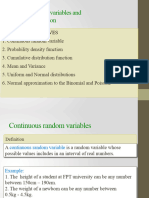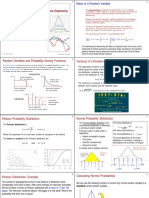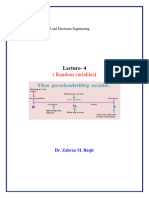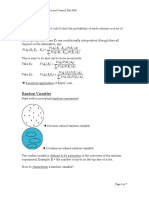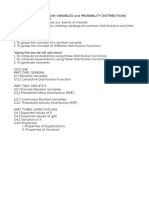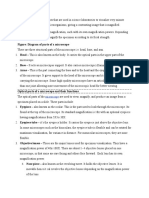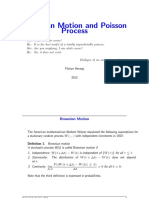Axdif
Axdif
Uploaded by
Peter NewmanCopyright:
Available Formats
Axdif
Axdif
Uploaded by
Peter NewmanOriginal Description:
Original Title
Copyright
Available Formats
Share this document
Did you find this document useful?
Is this content inappropriate?
Copyright:
Available Formats
Axdif
Axdif
Uploaded by
Peter NewmanCopyright:
Available Formats
Random Variables
Monotonic Transformations
Expectations
PSCI 356: STATISTICS FOR POLITICAL RESEARCH I
Class 5: Probability Theory: Random Variables and Distribution Functions II
Random Variables
Monotonic Transformations
Expectations
Outline
Random Variables Discrete Random Variables Continuous Random Variables Monotonic Transformations Expectations Properties of Expectations Measures of Dispersion
Random Variables Continuous Random Variables
Monotonic Transformations
Expectations
Random Variables
Random Variable: numerical outcome of a random experiment.
1
Denition: A discrete random variable is a random variable that can take on only a nite (or countably innite) number of values. Denition: A continuous random variable is a random variable that can take on a continuum of values (uncountable number of values).
Let F (x ) be the CDF for a continuous random variable X . Properties of F (same as for discrete random variables):
limx F (x ) = 0, limx + F (x ) = 1 F (x ) is increasing so x1 < x2 F (x1 ) F (x2 )
The CDF is a smooth increasing function over some interval of real numbers.
Random Variables Continuous Random Variables
Monotonic Transformations
Expectations
Continuous Random Variables
In dealing with continuous random variables, we talk about the distribution of the random variable over the sample space in terms of the probability density function [PDF] not probability mass functions. Denition: The CDF of a continuous random variable is x F (x ) = P (X x ) = f (x ) x . If f is continuous at x , then the PDF is f (x ) = F (x )/ y . In other words, the PDF is the derivative of the CDF. A PDF f (x ) is a function such that: f (x ) 0 for all x , < x < + f is piecewise continuous, and f (x ) x = 1. These conditions imply that: P (a X b) =
b a
f (X ) X .
By denition of F (x ), P (a X b) = F (b) F (a).
Random Variables Continuous Random Variables
Monotonic Transformations
Expectations
Continuous Random Variables EXAMPLE: The Uniform distribution on the interval [0, 1] chooses any number between 0 and 1. The PDF of the Uniform is given by: 1 if 0 x 1 f (x ) = 0 else f(x)
Random Variables Continuous Random Variables
Monotonic Transformations
Expectations
Continuous Random Variables
EXAMPLE: Uniform Distribution
A consequence is that P (X = a) =
a a
f (x ) x = 0.
The probability that a given value for a continuous random variable is realized is 0. Why is this the case? If the probability of observing the realization a was any positive probability, it would be the same for any number (by denition of the Uniform). But then the sum of any countably innity subset of [0,1] (e.g., the set of rationals) would be > , which is not possible. If P (X = x ) = p > 0, then F (x ) would have a discontinuity (jump) of size p at point x, violating the assumption of continuity. Practically speaking, what is the likelihood of seeing rainfall measurement of exactly 3.435 inches?
Random Variables Continuous Random Variables
Monotonic Transformations
Expectations
Continuous Random Variables
EXAMPLE: Uniform Distribution The CDF of the Uniform Distribution described above is (note the pdf is just the derivative of F (x ): given by: 0 if x < 0 x if 0 x 1 F (x ) = 1 if x > 1 f (x ) = 1 0 if 0 x 1 else
Pr(X <= x)
0.0 2
0.4
0.8
0 x
Random Variables Continuous Random Variables
Monotonic Transformations
Expectations
Continuous Random Variables
Normal Probability Distributions
(Standard) Normal Probability Distribution or Gaussian Distribution: bell shaped curve
For > 0 and , Y is a normal random variable if the probability distribution is dened as: 2 2 1 e(x ) /(2 ) , x p(X = x ) = p(x ) = 2 Standard Normal: = 0 and = 1
Random Variables Continuous Random Variables
Monotonic Transformations
Expectations
Continuous Random Variables
Normal Probability Distributions
How might Gauss have guessed this?
Random Variables Continuous Random Variables
Monotonic Transformations
Expectations
Continuous Random Variables
Standard Normal Probability Distributions
Random Variables Continuous Random Variables
Monotonic Transformations
Expectations
Continuous Random Variables
Other Probability Distributions
Gamma Binomial Probability Distribution Beta Probability Distribution
Random Variables
Monotonic Transformations
Expectations
Monotonic Transformation
Suppose g(x) is a strictly monotone function with inverse g 1 (). Let Y be {y |g (x ) = y for some x X )}. Suppose that fX (x ) is continuous. Then
fY (y ) = fX (g 1 (y ))
g 1 y (y )
, on Y .
WHY? FY (y ) = P (Y y ) = P (g (X ) y ) = P (X g 1 (y )) = FX (g 1 (y )). Then take derivative using the chain rule.
Random Variables
Monotonic Transformations
Expectations
Monotonic Transformation
EXAMPLE: Say pdf fX (x ) = exp(x ), x > 0 and 0 elsewhere Find the pdf for Y = 1/X
fY (y ) = e(1/y )
y
1 y2
Find the pdf for Y = ln(X)
fY (y ) = ee |ey |
Random Variables
Monotonic Transformations
Expectations
What have we learned?
Events in a sample space can be used to model experiments. Probability measure on the events enables us to evaluate the frequency of events. (Discrete and Continuous) random variables can be dened on the sample space to quantify events. Random variables can be described/characterized using pmf/pdf and cdf. However, is there a summary measure of a quantity of interest that can be used to characterize the outcome of the experiment? Of course there is. We refer to such quantities as moments.
Random Variables
Monotonic Transformations
Expectations
Measures of Central Tendency
Discrete Random Variable: Expected Value E[X] One characteristic that we might desire is the expected realization of the random variable X. For a discrete random variable X with values xi , 1 = 1...N , we calculate the expected value (or expectation or mean or the mean of the probability distribution) as follows:
N
E [X ] =
i =1
xi f (xi ) = = x
EXAMPLE 1 Let X be the number of heads in 2 fair coin tosses. Then E [X ] = 0 1/4 + 1 1/2 + 2 1/4 = 1.
.50 Pr(X=x) 0 .25
Random Variables
Monotonic Transformations
Expectations
Measures of Central Tendency
Discrete Random Variable: Median(X)
An alternative measure of central tendency is given by the median of a random variable. The median xM of random variable X is dened as the choice xM such that P (X xM ) 1/2.
Pr(X < x) 0.8 0.0 2 0.4
For the experiment described above, note that xM = 1. x Also realize that, by denition, whereas the median depends only on the rank ordering of the realizations of X, the mean depends on the actual values of X. In other words, since the realizations xi i 1...N enter into our calculations, the mean is sensitive to extreme values (sometimes called outliers").
Random Variables
Monotonic Transformations
Expectations
Measures of Central Tendency
Example: Mean vs. Median
EXAMPLE Consider the random variables X and Y with the following PMF. x f(x) y f(y) 0 .5 0 .5 1 .49 1 .5 1000000 .01
What is E[X] and E[Y] = ? What is the median of X and Y = ? E[X] = .5 E[Y] = 10000.49 Median of X and Y are both .5
Random Variables
Monotonic Transformations
Expectations
Measures of Central Tendency
Discrete Random Variable: Mode(X)
We can also dene the mode of a random variable, which is the element of X that occurs most frequently. mode(X ) = value of xi which maximizes p(xi )
Random Variables
Monotonic Transformations
Expectations
Measures of Central Tendency
Discrete Random Variable
N = E [X ] = =x i =1 xi f (xi ) median(X ) = xM such that P (X xM ) 1/2 mode(X ) = value of xi which maximizes p(xi )
Continuous Random Variable = E [X ] = xf (x ) x =x xM median(X ) = xM such that f (x ) x 1/2 mode(X ) = Value of xi which maximizes f (xi )
Random Variables
Monotonic Transformations
Expectations
Measures of Central Tendency EXAMPLE Suppose f (x ) = 2x 3 x > 1. Calculate the expected value, median and mode.
f(x) 0.0 1 1.0
2.0
3.0
1 x
Random Variables
Monotonic Transformations
Expectations
Measures of Central Tendency
EXAMPLE Suppose f (x ) = 2x 3 x > 1. Calculate the expected value, median and mode. E [X ] = = = = = = = x 2x 3 x b limb 1 x 2x 3 x 1 b limb 1 2x 2 x b limb 2 1 x 2 x 2 limb 2 2
1 x 1 1 2 2 limb b 1 1
b 1
1 2
f (x ) x limb a f (x ) x by standard improper integral results. Since kf (x ) x = k f (x ) x . 3 By Power Rule": x n x = 1/(n + 1)x n+1 for n = 1.
Random Variables
Monotonic Transformations
Expectations
Measures of Central Tendency
EXAMPLE Suppose f (x ) = 2x 3 x > 1. Calculate the expected value, median and mode. The median of X is solved for as follows.
1 2 1 2 1 2 1 m2
= =
m 1
2x 3 x
m 1
= = m=
1 x 2 2 1 1 1 m2 1 2
Inspection of the PDF reveals that the mode of X is obviously at 1. Note that as the above example indicates, there is no reason to expect that all measures of central tendency will be identical. Consequently, depending on the measure you choose, your characterization of the random variable may differ. Furthermore, there is no necessary reason for the median and mode to be unique although it is the case that the mean (E[X]) is unique.
Random Variables
Monotonic Transformations
Expectations
Measures of Central Tendency
EXAMPLE Consider the random variable X with the following PMF. x f(x) 0 .2 1 .3 2 .1 3 .3 4 .1
E [X ] = 0(.2) + 1(.3) + 2(.1) + 3(.3) + 4(.1) = 1.8.4 mode(X ) = {1, 3} 1 5 median(X ) [1, 2] since P (X < xm ) 1 2 and P (X > xm ) 2 .
4 5
Note that there is no reason why E[X] has to be an actual value of X. Sometimes expresses as 1.5.
Random Variables Properties of Expectations
Monotonic Transformations
Expectations
Properties of Expectations
For any function of the random variable g(x) we can still calculate the expected value of the transformed" random variable using the following result:
E [g (x )] =
x
g (xi )f (xi ) if X discrete
E [g (x )] =
g (x )f (x ) x if X continuous
Note that it is not the case that E [X 2 ] = (E [X ])2 .
Random Variables Properties of Expectations
Monotonic Transformations
Expectations
Properties of Expectations
EXAMPLE Consider the random variable X with the following PMF. x f (x ) 0 .5 1 .5 x2 f (x 2 ) 0 .5 1 .5
E [X ] = 0(.5) + 1(.5) = .5 implying that (E [X ])2 = .52 = .25. E [X 2 ] = 0(.5) + 1(.5) = .5. EXAMPLE Let g(x) = a + b(x). E [a + bX ] = = = = =
(a + bx )f (x ) x af (x ) x + bxf (x ) x a f (x ) x + b xf (x ) x 6 a 1 + b E [X ]
a + bE [X ]
As the above example demonstrates, for a constant c, E [c ] = c , and E [cX ] = cE [X ]
By denition of the PDF and E[X] respectively.
Random Variables Measures of Dispersion
Monotonic Transformations
Expectations
Measures of Dispersion
Just as there are several measures of central tendency, so too are there several measures of dispersion. The two most commonly used are the range and the variance. The range is dened as: range(X) = max(X) - min(X). Note that it is usually very uninformative. A more useful description of a random variables dispersion is given by the variance. Intuitively, the variance of a random variable measures how much the random variable X typically" deviates from its typical" value (or distance from the population mean). Mathematically: Var [X ] = E [(X E [X ])2 ]. 2 = E [(X E [X ])2 ] = E [X ])2 f (x ) if X is discrete (x E [X ])2 f (x ) x if X is continuous x
x (x
Random Variables Measures of Dispersion
Monotonic Transformations
Expectations
Measures of Dispersion
Why is the difference squared? Well, suppose not.
i (xi
E [X ])f (x ) = = = =
i xi f (x ) i E [X ]f (x ) E [X ] E [X ] i f (x )7 E [X ] E [X ]8 0.
In other words, the average deviation of X from its average is always 0; values above the mean cancel out values below the mean by denition of the mean. Consequently, we need to square the difference. Note that we could also take the absolute difference but that is harder" to work with mathematically.
7 8
By denition of E[X] and since E[X] is a constant respectively. Since i f (x ) = 1 by denition of probability.
Random Variables Measures of Dispersion
Monotonic Transformations
Expectations
Measures of Dispersion
EXAMPLE x f (x ) 1 .2 2 .2 3 .2 4 .2 5 .2
E [X ] = 1(.2) + 2(.2) + 3(.2) + 4(.2) + 5(.2) = .2 + .4 + .6 + .8 + 1 = 3 Var [X ] = E [(X E [X ])2 ] = (1 3)2 (.2) + (2 3)2 (.2) + (3 3)2 (.2) + (4 3)2 (.2) + (5 3)2 (.2) = 2.5
Random Variables Measures of Dispersion
Monotonic Transformations
Expectations
Measures of Dispersion
We can also derive another expression for the variance. E [(X E [X ])2 ] = = = = = E [X 2 2XE [X ] + (E [X ])2 ] E [X 2 ] 2E [XE [X ]] + E [(E [X ])2 ] E [X 2 ] 2E [X ]E [X ] + E [(E [X ])2 ] E [X 2 ] 2E [X ]2 + E [X ]2 E [X 2 ] E [X ]2
Random Variables Measures of Dispersion
Monotonic Transformations
Expectations
Measures of Dispersion
EXAMPLE Consider the continuous random variable with the PDF. Calculate Var[X]. f (x ) = 2(1 x ) 0
1 0
if 0 < x < 1 else
= E [X ] = = = = = = E [X ]2 =
x 2(1 x ) x
1 2 0 x x x 1 1 2 0 x x 0 x x 1 2 1 1 3 1 x ]0 3 x ]0 2 1 1 3 2 1 1 = 3 6 2 1 9
2 2 2 2 2
1 3
Random Variables Measures of Dispersion
Monotonic Transformations
Expectations
Measures of Dispersion
E [X 2 ] = = = = = = 2 = Var [X ]
1 0
x 2 2(1 x ) x
1 2 3 0 x x x 1 2 1 3 0 x x 0 x x 1 3 1 x ]0 1 x 4 ]1 0 3 4 1 1 3 4 1 1 = 6 12
2 2 2 2 2
= E [X 2 ] E [X ] 2 = 1 1 6 9 1 = 18
Random Variables Measures of Dispersion
Monotonic Transformations
Expectations
Measures of Dispersion
The interpretation of the variance may not be that intuitive, as it tells us the average squared deviation of a random variable X. Consequently, if X is measured in dollars, Var[X] is measures in squared dollars. To make interpretation easier, we often times refer to the standard deviation of a random variable. The standard deviation is simply the square root of the variance. More generally, we can characterize a random variable using a moment generating function. The moment generating function allows us to dene a sequence of moments which can completely characterize the probability distribution.
The kth moment around zero is dened as E [0 E [X ]]k or E [X ]k . Note that the rst moment about zero is the mean: E[X]. The kth moment around the mean is dened as: E [(X E [X ])k ]. The second moment about the mean is the variance.
Random Variables Measures of Dispersion
Monotonic Transformations
Expectations
Measures of Dispersion
Why is this terminology useful? Because it provides a common framework for talking about our measures of central tendency and dispersion. Higher moments about the mean also have special terms associated with them. The third moment around the mean E [(X E [X ])3 ] is called the skew of the distribution. The skew tells us whether the dispersion about the mean is symmetric (if skew = 0 ), or if it is negatively skewed (if skew < 0; implying that E[X] < median(X)) or positively skewed (if skew > 0; implying that E[X] > median(X)).
Random Variables Measures of Dispersion
Monotonic Transformations
Expectations
Measures of Dispersion
Skewness
Positive Skew
0.04 EX med[X] Density 0.02 0.00
50
100 x
150
Symmetric
0.015 0.010
Density
EX
0.005
med[X]
0.000
50
100 x
150
Negative Skew
0.04
EX med[X]
Density
0.00
0.02
50
100 x
150
Random Variables Measures of Dispersion
Monotonic Transformations
Expectations
Measures of Dispersion
Kurtosis
The fourth moment about the mean E [(X E [X ])4 ] is known as the kurtosis and it measures how thick the tails" of the distribution are.9
When measure using higher powers we often normalize and use
E [(X E [X ])k ] ( Var [X ])k
because E [(X E [X ])k ] increases dramatically as k increases.
Random Variables Measures of Dispersion
Monotonic Transformations
Expectations
Measures of Dispersion
Kurtosis
0.020
0.015
Density
Density 0 50 x 150
0.010
0.005
0.000
0.000 0 50 x
0.005
0.010
0.015
0.020
150
Random Variables Measures of Dispersion
Monotonic Transformations
Expectations
Measures of Dispersion
Example: Normal Distribution
EXAMPLE The Normal Distribution (also sometimes called the Gaussian Distribution) is completely characterized by two moments. The PDF is: 2 1 (x ) 1 f (x |, 2 ) = e 2 2 2 where E [X ] = and Var [X ] = 2 . Since two parameters dene a normal distribution, we denote this by: X N (, 2 ). In doing empirical work, it is always important to understand what the characteristics are of the data you are working with. A good rst step is to calculate the summary statistics of variables you work with as well as plot them out so you can visualize what you are working with. Doing so will also (hopefully) help you catch errors and identify outliers for further investigation.
Random Variables Measures of Dispersion
Monotonic Transformations
Expectations
Measures of Dispersion
If X is a random variable with nite variance, then for any constants a and b, Var [aX + b] = = = = = E [(aX + b) E [(aX + b)]2 E [aX + b aE [X ] b]2 E [aX aE [X ]]2 a2 E [X E [X ]]2 a2 Var [X ]
You might also like
- Bondstrand 2400 SeriesDocument20 pagesBondstrand 2400 SeriesTommytoo BernalNo ratings yet
- Chapter 4-6Document39 pagesChapter 4-6abiysemagn460No ratings yet
- CH 3Document22 pagesCH 3Agam Reddy MNo ratings yet
- Random VariablesDocument11 pagesRandom VariablesJoaquin MelgarejoNo ratings yet
- Random Variables - Definition, Types, Examples & FormulaDocument19 pagesRandom Variables - Definition, Types, Examples & Formulaolaosebikanibrahim2019No ratings yet
- Probability PresentationDocument26 pagesProbability PresentationNada KamalNo ratings yet
- OptimalLinearFilters PDFDocument107 pagesOptimalLinearFilters PDFAbdalmoedAlaiashyNo ratings yet
- STAE Lecture Notes - LU5Document22 pagesSTAE Lecture Notes - LU5aneenzenda06No ratings yet
- Chap 2Document55 pagesChap 2stellla.1721147390No ratings yet
- Basic Statistics For LmsDocument23 pagesBasic Statistics For Lmshaffa0% (1)
- Lecture Notes Week 1Document10 pagesLecture Notes Week 1tarik BenseddikNo ratings yet
- SLIDES Probability-Part3Document17 pagesSLIDES Probability-Part3nganda234082eNo ratings yet
- Probability Formula SheetDocument11 pagesProbability Formula SheetJake RoosenbloomNo ratings yet
- QT-Random Variable and Probability Distribution-1Document4 pagesQT-Random Variable and Probability Distribution-1nikhithakleninNo ratings yet
- BSTA 2104 Probability and Statistics II Notes Sep Dec 2024Document75 pagesBSTA 2104 Probability and Statistics II Notes Sep Dec 2024nyandikajustin57No ratings yet
- Slide Chap4Document22 pagesSlide Chap4pmthai201No ratings yet
- Slide Chap4Document19 pagesSlide Chap4dangxuanhuy3108No ratings yet
- M3L08Document9 pagesM3L08abimanaNo ratings yet
- Risk Analysis For Information and Systems Engineering: INSE 6320 - Week 3Document9 pagesRisk Analysis For Information and Systems Engineering: INSE 6320 - Week 3ALIKNFNo ratings yet
- LEC4NDocument10 pagesLEC4N4nsjwty8whNo ratings yet
- Theories Joint DistributionDocument25 pagesTheories Joint DistributionPaul GokoolNo ratings yet
- Chapter Two 2. Random Variables and Probability DistributionsDocument15 pagesChapter Two 2. Random Variables and Probability DistributionsabdihalimNo ratings yet
- Review of Basic Probability: 1.1 Random Variables and DistributionsDocument8 pagesReview of Basic Probability: 1.1 Random Variables and DistributionsJung Yoon SongNo ratings yet
- Chapter 4 Probability ReviewDocument20 pagesChapter 4 Probability ReviewŞamil ŞirinNo ratings yet
- Review02-Random VariablesDocument39 pagesReview02-Random VariableskazunsanjayaNo ratings yet
- LECT3 Probability TheoryDocument42 pagesLECT3 Probability Theoryhimaanshu09No ratings yet
- Pa E E: Random VariablesDocument7 pagesPa E E: Random VariablesMariam MugheesNo ratings yet
- Chapter 3: Random Variables and Probability Distributions This Chapter Is All AboutDocument8 pagesChapter 3: Random Variables and Probability Distributions This Chapter Is All Aboutanon_257748454No ratings yet
- Unit 1 - 03Document10 pagesUnit 1 - 03Raja RamachandranNo ratings yet
- CSD4101 Probability DistributionsDocument4 pagesCSD4101 Probability DistributionsShubham WaghNo ratings yet
- Class6 Prep ADocument7 pagesClass6 Prep AMariaTintashNo ratings yet
- ANG2ed 3 RDocument135 pagesANG2ed 3 Rbenieo96No ratings yet
- Chapter 2Document25 pagesChapter 2McNemarNo ratings yet
- Business Inferential Statistics LessonsDocument7 pagesBusiness Inferential Statistics Lessonsblessingszingwangwa49No ratings yet
- Chapter 4Document36 pagesChapter 4Sumedh KakdeNo ratings yet
- Chapter 4Document21 pagesChapter 4Anonymous szIAUJ2rQ080% (5)
- Chapitre 2Document6 pagesChapitre 2chihabhliwaNo ratings yet
- Random VariablesDocument31 pagesRandom VariablesDanila RibeiroNo ratings yet
- Week 6Document6 pagesWeek 6Gautham GiriNo ratings yet
- Stats Cheat SheetsDocument15 pagesStats Cheat SheetsClaudia YangNo ratings yet
- Financial Engineering & Risk Management: Review of Basic ProbabilityDocument46 pagesFinancial Engineering & Risk Management: Review of Basic Probabilityshanky1124No ratings yet
- Some Continuous and Discrete Distributions: X y B ADocument8 pagesSome Continuous and Discrete Distributions: X y B ASandipa MalakarNo ratings yet
- Handout 03 Continuous Random VariablesDocument18 pagesHandout 03 Continuous Random Variablesmuhammad ali100% (1)
- Slide Chap4Document19 pagesSlide Chap4Ton Khanh LinhNo ratings yet
- CHAPTER TWO (2) SDocument69 pagesCHAPTER TWO (2) Skaleabs321No ratings yet
- Engineering Uncertainty NotesDocument15 pagesEngineering Uncertainty NotesKaren Chong YapNo ratings yet
- Ch4Document71 pagesCh4吳焯文No ratings yet
- Chapter 3: Random Variables and Probability DistributionsDocument54 pagesChapter 3: Random Variables and Probability Distributionsمؤيد العتيبيNo ratings yet
- Discrete Probability Distribution Chapter3Document47 pagesDiscrete Probability Distribution Chapter3TARA NATH POUDELNo ratings yet
- Lecture11 (Week 12) UpdatedDocument34 pagesLecture11 (Week 12) UpdatedBrian LiNo ratings yet
- Chapter 5 Functions of Random VariablesDocument29 pagesChapter 5 Functions of Random VariablesAssimi DembéléNo ratings yet
- CS 4850-Lecture 1Document3 pagesCS 4850-Lecture 1Sean LiNo ratings yet
- Chapter3-Discrete DistributionDocument141 pagesChapter3-Discrete DistributionjayNo ratings yet
- Unit 4.Document14 pagesUnit 4.Avi HamalNo ratings yet
- Probability BasicsDocument19 pagesProbability BasicsFaraz HayatNo ratings yet
- 408continuous PDFDocument2 pages408continuous PDFjorgeNo ratings yet
- Probability DistributionDocument21 pagesProbability Distributiontaysirbest0% (1)
- Calculus-chapter 2_edited VersionDocument157 pagesCalculus-chapter 2_edited Versionboodavid20No ratings yet
- Green's Function Estimates for Lattice Schrödinger Operators and ApplicationsFrom EverandGreen's Function Estimates for Lattice Schrödinger Operators and ApplicationsNo ratings yet
- Mathematics 1St First Order Linear Differential Equations 2Nd Second Order Linear Differential Equations Laplace Fourier Bessel MathematicsFrom EverandMathematics 1St First Order Linear Differential Equations 2Nd Second Order Linear Differential Equations Laplace Fourier Bessel MathematicsNo ratings yet
- PPTDocument29 pagesPPTcharan88No ratings yet
- Review On Emergency Operating Procedures For APR1400: Feed-and-Bleed and RCS Rapid Cooldown in SLOCADocument3 pagesReview On Emergency Operating Procedures For APR1400: Feed-and-Bleed and RCS Rapid Cooldown in SLOCAelsayedNo ratings yet
- Influence of Specimen Preparation and Nanoindentation Protocol On The Mechanical Properties of Bovine BoneDocument4 pagesInfluence of Specimen Preparation and Nanoindentation Protocol On The Mechanical Properties of Bovine BoneLenard MesarosNo ratings yet
- Lesson 1 SubstitutionDocument23 pagesLesson 1 SubstitutionAdina TulbureNo ratings yet
- GT8BC and 8C - C2 Comp Upgrade - April2008 - FVDocument4 pagesGT8BC and 8C - C2 Comp Upgrade - April2008 - FVt.o.i.n.g100% (1)
- Pcmflash 71Document163 pagesPcmflash 71Emi DNo ratings yet
- MicroscopeDocument3 pagesMicroscopeJannette Jane DavidNo ratings yet
- McCook Field History IIDocument84 pagesMcCook Field History IICAP History Library100% (1)
- Science 6 FrictionDocument3 pagesScience 6 Frictionanaliza balagosaNo ratings yet
- F1. SCT - SN-Steel Formwork Design - GTG BEAM FORMWORKDocument32 pagesF1. SCT - SN-Steel Formwork Design - GTG BEAM FORMWORKshihabNo ratings yet
- Development of Design Guidelines For Rural Low Volume Roads in MalaysiaDocument12 pagesDevelopment of Design Guidelines For Rural Low Volume Roads in MalaysiagabemzamanNo ratings yet
- Rotor: Excitation Transformers Are Use To Magnetize Generators andDocument8 pagesRotor: Excitation Transformers Are Use To Magnetize Generators andMian UsmanNo ratings yet
- All DatasheetsDocument485 pagesAll Datasheetssflynn79No ratings yet
- 01-Course Contents With Toc SYBTECH MED AY2018-19 r3 PDFDocument36 pages01-Course Contents With Toc SYBTECH MED AY2018-19 r3 PDFPraful GarjeNo ratings yet
- Ex05b - PDSP Question Paper - Te - 1Document4 pagesEx05b - PDSP Question Paper - Te - 1shankarNo ratings yet
- 2023 Unit 1 Lesson 1Document21 pages2023 Unit 1 Lesson 1Mr. CNo ratings yet
- Aits 2425 Pt III Td Jeea Paper 2 OfflineDocument12 pagesAits 2425 Pt III Td Jeea Paper 2 Offlinegiyohiy540No ratings yet
- Physics 2nd Semester NotesDocument6 pagesPhysics 2nd Semester NotesMaria HarounNo ratings yet
- A New Method of Dimensional Analysis FluDocument12 pagesA New Method of Dimensional Analysis FluMohammed ShamkhiNo ratings yet
- Product Geosynthetics ClassificationDocument2 pagesProduct Geosynthetics ClassificationErwin Nur WicaksonoNo ratings yet
- Microsoft PowerPoint - Lecture-1 - IntroDocument33 pagesMicrosoft PowerPoint - Lecture-1 - IntroIndhujaTNo ratings yet
- Wtm-045 RT Procedure Asme V 2010-V01Document18 pagesWtm-045 RT Procedure Asme V 2010-V01Wisüttisäk Peäröön100% (1)
- G4 Exp8Document9 pagesG4 Exp8Naresh GanisonNo ratings yet
- Finished Taiwan Course 2 KLIPPEL - Modal Vibration and DiagnosticDocument38 pagesFinished Taiwan Course 2 KLIPPEL - Modal Vibration and Diagnostic點潔No ratings yet
- PHYSICS Sba HandoutsDocument17 pagesPHYSICS Sba HandoutsFazeela Majid100% (1)
- Brownian Motion and Poisson ProcessDocument16 pagesBrownian Motion and Poisson ProcessSolisterADVNo ratings yet
- Material AlSiDocument2 pagesMaterial AlSidoanthanh88No ratings yet
- Quantum Physics Review QuestionsDocument4 pagesQuantum Physics Review Questionsjamesoconnell13No ratings yet
- 3-D Pushover Analysis of A Collapsed Reinforced Concrete ChimneyDocument9 pages3-D Pushover Analysis of A Collapsed Reinforced Concrete ChimneySrikant Bharadwaj VedulaNo ratings yet
















